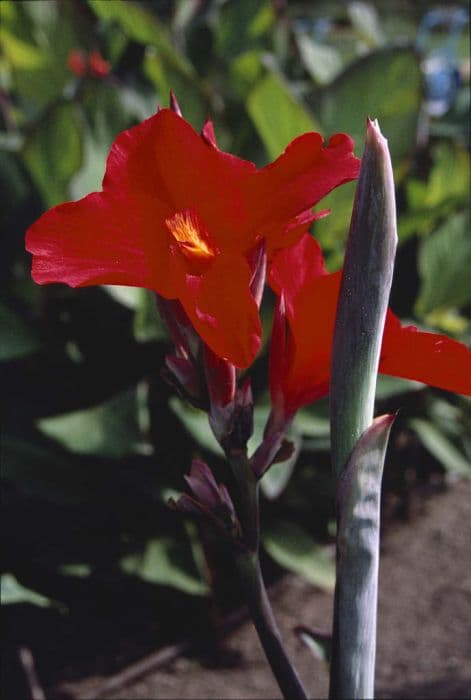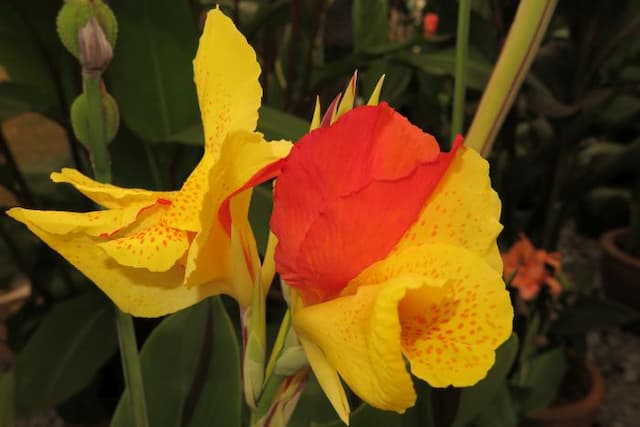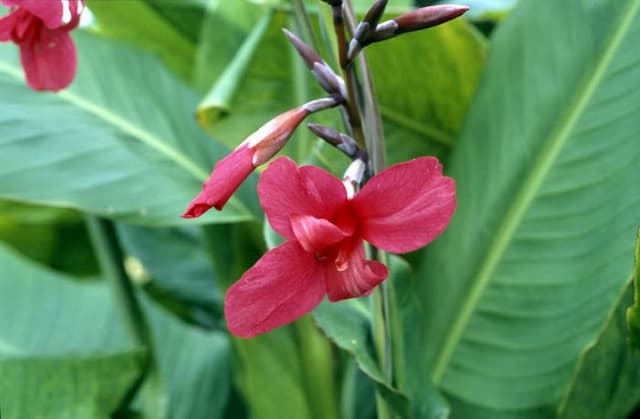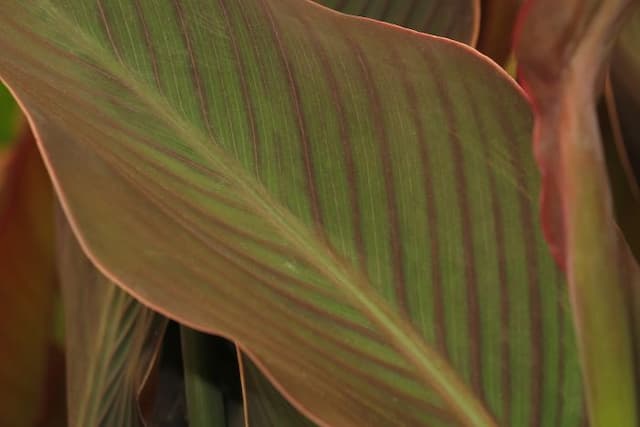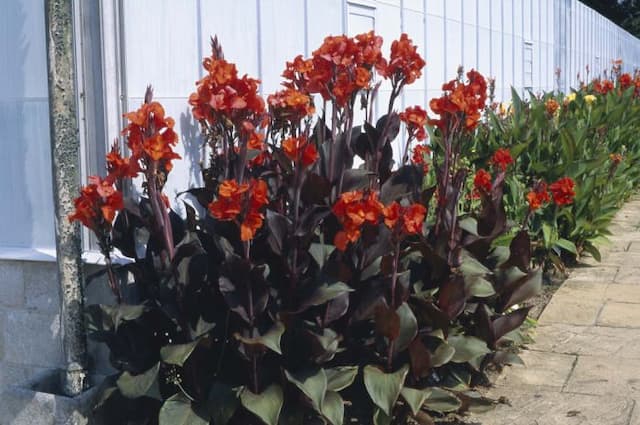Canna Lily Canna 'Wyoming'

ABOUT
Canna 'Wyoming' is a striking ornamental plant known for its bold and vibrant appearance. It is distinct for its rich, orange flowers that bloom atop tall stems, creating a striking contrast against the surrounding foliage. The blooms are typically iris-like in shape, exuding a tropical flair that can brighten up any garden space. The plant's large, paddle-shaped leaves are equally impressive, boasting a deep, bronzy-purple hue that often appears almost black, depending on the light. These leaves are broad and have a waxy texture, adding to the lush, exotic look of the plant. The overall impression of Canna 'Wyoming' is one of drama and intensity, with its showy flowers and dark, elegant foliage creating an eye-catching display.
About this plant
 Names
NamesSynonyms
Wyoming Canna, Tropicanna Black Canna, Canna Lily.
Common names
Canna 'Wyoming'.
 Toxicity
ToxicityTo humans
The Canna, including the 'Wyoming' variety, is generally considered non-toxic to humans. It is not known to cause serious poisoning if ingested. However, as with many plants, sensitive individuals might experience mild stomach upset or an allergic reaction if they consume parts of this plant. It is always advisable to avoid eating ornamental plants due to potential individual reactions and the possible presence of pesticides or other chemicals.
To pets
The Canna, including the 'Wyoming' variety, is not listed as toxic to pets such as dogs and cats. If a pet were to ingest part of this plant, it is unlikely to suffer from serious poisoning. However, ingestion could potentially cause mild gastrointestinal upset, such as vomiting or diarrhea, especially if consumed in large quantities. It's always wise to prevent pets from eating plants, as individual animals might have different sensitivities, and to ensure they do not have access to any plant treated with pesticides or other chemicals.
 Characteristics
CharacteristicsLife cycle
Perennials
Foliage type
Deciduous
Color of leaves
Green
Flower color
Orange
Height
4-6 feet (1.2-1.8 meters)
Spread
1-2 feet (0.3-0.6 meters)
Plant type
Bulb
Hardiness zones
7-10
Native area
South America
Benefits
 General Benefits
General Benefits- Ornamental Appeal: Features bold, striking foliage and vibrant orange flowers that add visual interest to gardens and landscapes.
- Drought Tolerance: Once established, it has good resistance to short periods of drought.
- Easy Propagation: Can be easily propagated through division, allowing gardeners to expand their display or share with others.
- Rapid Growth: Exhibits fast growth, quickly reaching its full size and creating a lush appearance in the garden.
- Low Maintenance: Requires minimal care once established, making it suitable for gardeners of all skill levels.
- Pest Resistant: Shows resilience against many common garden pests, reducing the need for chemical treatments.
- Attracts Pollinators: Flowers attract bees, butterflies, and hummingbirds, supporting local ecosystems.
- Seasonal Interest: Blooms from early summer to fall, providing long-lasting color and interest throughout the growing season.
- Versatility: Suitable for planting in beds, borders, and containers, offering flexibility in garden design and space usage.
- Soil Adaptability: Able to grow in a variety of soil types, although it prefers well-draining, fertile soil.
 Medical Properties
Medical PropertiesThis plant is not used for medical purposes.
 Air-purifying Qualities
Air-purifying QualitiesThis plant is not specifically known for air purifying qualities.
 Other Uses
Other Uses- Canna Wyoming can be used as a source of starch for small-scale production of bioplastics; its rhizomes contain a significant amount of starch that can be extracted and processed.
- As a component of living walls, the Canna Wyoming's large leaves can contribute to the aesthetics and design diversity of vertical gardens.
- The resilient nature of Canna Wyoming makes it suitable for phytoremediation, helping to clean toxins and heavy metals from contaminated soils.
- In areas prone to erosion, the robust root system of Canna Wyoming can be utilized in soil stabilization projects.
- Canna Wyoming can be grown in constructed wetlands, where they play a role in wastewater treatment systems by absorbing excess nutrients.
- As a subject for scientific research, Canna Wyoming offers opportunities to study genetic hybridization and plant adaptation attributes.
- The flowers of Canna Wyoming can be used in the production of natural dyes for textiles, offering a range of warm tones.
- Its large leaves can serve as natural biodegradable plates or wrappers for food, a practice common in some traditional societies.
- The robust foliage of Canna Wyoming is sometimes used in craft and paper-making projects due to its fibrous quality.
- Canna Wyoming can act as companion plants in agricultural settings, attracting beneficial insects while deterring pests with their height and leaf density.
Interesting Facts
 Feng Shui
Feng ShuiCanna is not used in Feng Shui practice.
 Zodiac Sign Compitability
Zodiac Sign CompitabilityCanna is not used in astrology practice.
 Plant Symbolism
Plant Symbolism- Confidence: The bold, bright blooms of Canna 'Wyoming' represent a sense of confidence and pride due to their prominent and showstopping appearance.
- Fiery Passion: With its deep orange-red flowers, this plant symbolizes intense passion and vibrance in love and other pursuits, reminiscent of fire's dynamic nature.
- Fertility and Abundance: The lush, green foliage and prolific flowering of the canna plant often symbolize fertility and the abundance of new growth or ideas.
- Transformation: Cannas undergo a transformation each season, dying back and reblooming with vigour, symbolizing resilience and the ability to adapt and reinvent oneself.
 Water
WaterCanna lilies, including 'Wyoming', should be watered to keep the soil consistently moist but never waterlogged. They typically require around 1 to 1.5 inches of water per week, depending on the weather conditions. If you're using a hose, provide about a gallon of water per plant, which should suffice for a week, unless it's unusually hot or dry. During peak summer heat, you might need to water twice a week. Always check the top inch of soil for dryness before watering again to prevent overwatering.
 Light
LightCanna lilies, including 'Wyoming', thrive in full sun conditions, where they can receive at least 6 to 8 hours of direct sunlight daily. The ideal spot for them is an open area with unfiltered sunlight, as plenty of light is crucial for the development of vibrant blooms. They can tolerate some light shade but flowering may be reduced in less than optimal light conditions.
 Temperature
TemperatureCanna lilies, such as 'Wyoming', prefer warm temperatures and are hardy to United States Department of Agriculture zones 7 to 10. They can handle temperatures as high as 90°F and should be protected if the temperature drops below 55°F. The ideal temperature range for these plants is between 70°F and 85°F for robust growth and flowering.
 Pruning
PruningCanna lilies, like 'Wyoming', should be pruned to remove spent flowers and damaged leaves, which encourages new growth and more blooms. Deadheading, or cutting off the old flowers, should be done throughout the blooming season. Prune back the foliage to the ground in late fall or after the first frost has killed the leaves, as part of the preparation for winter.
 Soil
SoilThe Canna Lily 'Wyoming', as a tropical perennial, thrives in rich, well-draining soil with a pH of 6.0 to 6.5. A mix of garden loam, peat, and coarse sand or perlite works well for this plant, ensuring adequate nutrition and proper drainage.
 Repotting
RepottingThe Canna Lily 'Wyoming' should be repotted every couple of years or when the rhizomes outgrow the pot. It's best to repot this plant in the spring before the growing season begins.
 Humidity & Misting
Humidity & MistingThe Canna Lily 'Wyoming' prefers a moderate to high humidity environment, but can tolerate a wide range. Aim for a humidity level between 40-60% for optimal growth.
 Suitable locations
Suitable locationsIndoor
Ensure bright light, warm temps, and sufficient moisture.
Outdoor
Plant in full sun, enriched soil, and water regularly.
Hardiness zone
7-11 USDA
 Life cycle
Life cycleThe Canna 'Wyoming', also known as Canna Lily, begins its life cycle as a dormant rhizome which, when planted and with the onset of warm weather, sprouts into vigorous growth with large, paddle-shaped leaves. The plant then develops tall stems that bear vibrant, orange flowers with a unique, tropical appearance throughout the summer months. After the flowering period, the plant sets seed in the form of small, round capsules, though many growers propagate Cannas vegetatively via division of the rhizomes. As temperatures cool in the fall, the Canna Lily's above-ground foliage dies back, and the plant enters a period of dormancy. Throughout the winter, the rhizomes survive underground, storing energy for the next growing season. With the return of warm temperatures in spring, the cycle begins anew as the rhizomes break dormancy and send up fresh shoots.
 Propogation
PropogationPropogation time
Spring to Summer
The Canna 'Wyoming', commonly known as the Wyoming Canna, is typically propagated through the division of rhizomes, which is the most popular method for this plant. The best time to propagate Cannas by division is in the spring, just before the new growth starts. To propagate by division, carefully dig up the clump of rhizomes after the plant has finished blooming or has gone dormant. Using a sharp knife or spade, divide the rhizomes into sections, ensuring each section has at least one eye, or bud, from which new growth will emerge. Trim any excessively long roots and remove old, spent foliage. The divided rhizomes can then be immediately replanted at a depth of about 4 to 6 inches (10 to 15 centimeters), spaced around 12 to 18 inches (30 to 45 centimeters) apart, to allow adequate room for growth. Keep the soil moist until the new shoots become established.

